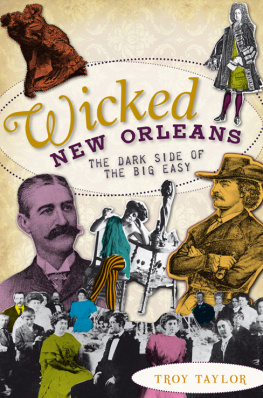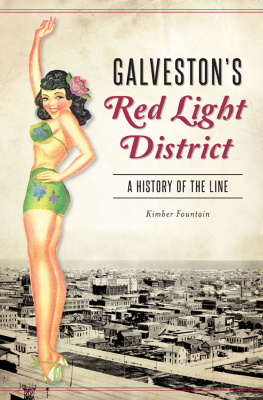SPECTACULAR WICKEDNESS
SPECTACULAR WICKEDNESS
SEX, RACE, AND MEMORY IN
STORYVILLE, NEW ORLEANS
EMILY EPSTEIN LANDAU

LOUISIANA STATE UNIVERSITY PRESS
BATON ROUGE
Published by Louisiana State University Press
Copyright 2013 by Louisiana State University Press
All rights reserved
Manufactured in the United States of America
First printing
Designer: Barbara Neely Bourgoyne
Typeface: Calluna
Printer: McNaughton & Gunn, Inc.
Binder: Dekker Bookbinding
Library of Congress Cataloging-in-Publication Data
Landau, Emily Epstein, 1969
Spectacular wickedness : sex, race, and memory in Storyville, New Orleans / Emily Epstein Landau.
p. cm.
Includes bibliographical references and index.
ISBN 978-0-8071-5014-6 (cloth : alk. paper) ISBN 978-0-8071-5015-3 (pdf) ISBN 978-0-8071-5016-0 (epub) ISBN 978-0-8071-5017-7 (mobi) 1. Red-light districtsLouisianaNew OrleansHistory20th century. 2. ProstitutionLouisianaNew Orleans History20th century. 3. BrothelsLouisianaNew OrleansHistory20th century. 4. PatriarchyLouisianaNew OrleansHistory20th century. 5. MasculinitySocial aspectsLouisianaNew OrleansHistory20th century. 6. WhitesLouisianaNew OrleansAttitudesHistory20th century. 7. Storyville (New Orleans, La.) History 20th century. 8. New Orleans (La.) Race relationsHistory20th century. 9. New Orleans (La.) sHistory20th century. I. Title.
HQ146.N6L36 2013
306.7409763dc23
2012034237
The paper in this book meets the guidelines for permanence and durability of the Committee on Production Guidelines for Book Longevity of the Council on Library Resources. 
For Paul, Zoe, and Penelope

The contents of this book are the facts and not dreams from a hop joint.
STORYVILLE BLUE BOOKS

CONTENTS
INTRODUCTION
Land of Dreams
CHAPTER ONE
The Promised Land of Harlotry
CHAPTER TWO
The Quadroon Connection
CHAPTER THREE
Public Rights and Public Women
CHAPTER FOUR
Where the Light and Dark Folks Meet
CHAPTER FIVE
Diamond Queen
CHAPTER SIX
The Last Stronghold of the Old Regime
CONCLUSION
Farewell to Storyville
ACKNOWLEDGMENTS
This book began with a paper for David Brion Davis at Yale University. I wanted to explore the links between chattel slavery and free women of color practicing prostitution in the antebellum South. Professor Davis suggested that I look at a later period, and pointed me toward New Orleans. It was during the research for that project that I discovered the Blue Books, the famous guides to Storyville. These books, three of which are at Yales Beinecke Rare Book and Manuscript Library, early on became my own guides to researching and writing the dissertation, and then the book. A summer research fellowship at the Beinecke gave me the opportunity to read, in addition to the Blue Books, volumes of descriptive literature on New Orleans.
Numerous people helped me as I conducted my research in New Orleans over the years. I would like to thank Sarah Wheelock for introducing me to her friends in New Orleans, who put me up in their drafty house on Terpsichore Street. In several subsequent visits, Rachel Devlin let me stay at her Garden District apartment. Karen and Michael Leathem also took me in, providing me with a place to stay as well as their wonderful company, cooking, and endless knowledge about New Orleans. Karen and Michael always know exactly where to eat in New Orleans, and some of the best meals Ive had in my life have been with them. I met Mike Ross at a conference in 2000, and one summer I house-sat for him, though it was he doing me the favor. At that same conference I met Rebecca Scott, who shared some fascinating information about Armand Romain with me. Her work on Cuba, Louisiana, and creole itineraries has influenced my thinking considerably since that first meeting. I thank her, too, for her incisive comments on a conference paper I delivered in 2012. Throughout the process of research and writing, I have been grateful to Alecia P. Long. Alecia has been exceedingly generous with me in sharing sources and insights, and her wonderful book The Great Southern Babylon is a model work of scholarship. Her next project promises to be the same.
I conducted the bulk of my research at the New Orleans Public Library, which houses the city archives. Irene Wainwright and Wayne Everard worked tirelessly with me, retrieving files and guiding me through their massive microfilm collections, as well as helping me figure out which sources would be particularly useful. Wayne has since retired, but he still comes in to the library to volunteer his time and voluminous knowledge. Greg Osborn also knows the city extremely well, its geography as well as its history, and he has been instrumental in helping me get to know it, too. The records at the city archives are stored folded in the basement. Before a researcher can read them, the files must be humidified overnightso they do not break unfolded, flattened, and placed in a properly labeled folder. Greg is often tasked with performing this service, and I am grateful. I would also like to thank Maya Lopez, Stephen Kuehling, and Charlie Brown for their help at the city archives.
I also spent many hours at the William Ransom Hogan Jazz Archive at Tulane University. Bruce Raeburns knowledge of jazz music and its history, and of Storyville, have been indispensable to this project, up to and including selecting the images for the book. Alma Williams and Charles Chamberlain were unsparing in their aid and tireless in finding me materials. Thanks to Lynn Abbott for sending me the images for the book. At the Louisiana Collections at Tulane, I owe a special debt to Kevin Fontenot for his help, conversation, and general friendliness. Sherrie Tucker shared her work on women in New Orleans jazz, and I am grateful to her for it. Tad Jones, who tragically passed away shortly after Hurricane Katrina, shared numerous articles about Storyville with me, sending many of them to me at home in Washington. He is missed.
At the University of New Orleans, Marie Windell retrieved Supreme Court cases and copied countless pages for me. Her knowledge of the archives and of Louisiana legal history, and her wonderful demeanor and helpful hints, made working at the Earl K. Long library a special treat. Also helpful at UNO was John Kelly, especially with images. The Williams Research Center of the Historic New Orleans Collection contains the largest selection of Blue Books and other guides to Storyville. Pamela Arceneaux is an expert in the guides and was a wonderful guide for me as I navigated my way through them. Mark Cave was always on hand to help me find something I was looking for, and to point out another useful source. At the New Orleans Notarial Archives, Sally Reeves helped me immeasurably in tracing property ownership and transfers within Storyville. During my time at the Notarial Archives I often ran into Shirley Thompson, who was always engaging, and whose wonderful book, Exiles at Home, offers a brilliant analysis of the history of New Orleanss Creoles of color.
While in graduate school, I received a fellowship from the Social Science Research Council under their Sexuality Fellowship Research Program, funded by the Ford Foundation. The fellowship provided funds for my first year of writing and to have the collection of Blue Books at the Williams Research Center microfilmed. This made it possible for me to continue my analysis of the Blue Books in Washington without necessitating constant travel back and forth to New Orleans. Moreover, the books are quite brittle now, and the archive restricts their use. Now they will be available to researchers much more broadly.
Next page



![Schwam - Frommers New Orleans [2011]](/uploads/posts/book/250009/thumbs/schwam-frommer-s-new-orleans-2011.jpg)


